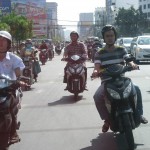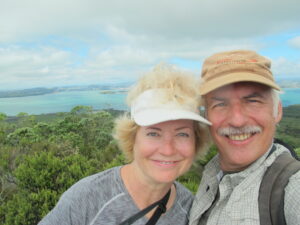To the novice driver or a non-native, traffic in SE Asia may seem chaotic and undisciplined, with cars and motorcycles hurtling about each other. That is far from the truth. In reality, most drivers follow well-known rules in handling their vehicles.
This manual explains the simple rules of the road here. It will prepare you for the challenges of driving in SE Asia, no matter in which country you are foolhardy enough to do it.

You need only study the manual, obtain a vehicle (to include motorbike, scooter, electric bike, car, truck or anything else that moves quickly) and off you go. No other qualifications needed, and no discrimination by age, sex or country of national origin. If you are a foreigner, however, you should acquire an international driver’s license (from auto clubs, etc.) that affirm in various languages that you are in fact a living person.
As an alternative to reading the manual, careful study of actual street conditions will give you the same accurate and invaluable information.
I. Rules of the Road
There are only two rules of the road in SE Asia:
1. Proceed as quickly as you can, to keep you and the rest of traffic moving.
2. Avoid hitting anything (for, if you do, you will violate rule 1).
II. Legitimate lanes of vehicle travel
In order to follow rule 1, you should make a lane for your vehicle whenever possible. On a two lane road, this typically means 5 lanes of traffic, particularly when you can pass motorbikes or similar two wheeled vehicles. On a four lane highway, you can generally create up to 10 lanes of traffic. Add two more lanes if you can when the the road has paved shoulders. Clearly, to do this, you want to pass a vehicle as tightly as you can so you and they can maximize lanes, as long as you avoid hitting anything (rule 2).
III. Intersections
Do not stop when entering most intersections or rotary/roundabouts. You may slow down if some vehicle on the cross street is in front of you, so you can obey rule 2 (avoid hitting anything). Otherwise, it is best to just keep going and make the cross traffic obey rule 2 instead.
On rare occasions, you will encounter a red light system. When the light turns red, keep going until you see actual cross-traffic entering the space in front of you. As the light turns green (or the countdown timer moves toward zero), vehicles at the front of the lane should start moving and gain momentum so they can get into the intersection just as the last vehicle in the cross-traffic clears.
IV. Left turns (or right turns in Thailand which uses the British system)
There is much confusion about the proper way to make a left turn at a city intersection with two lanes in each direction. Many drivers make the mistake of staying in their own lane as they move into the intersection and then stopping while the opposing traffic clears. This is a mistake, as the opposing traffic never clears, and you will be unnecessarily slowing down the vehicles behind you. Instead, you should severely cut the corner, slanting across the two lanes to your left just as you enter the intersection. In other words, before you enter the intersection, start moving into the opposing lane so that you will slow the traffic coming at you or cause them to flow around you. Proceed slowly across this opposing lane and then across the opposing traffic in the leftmost lane of the cross street until you reach the correct lane. Honk vigorously as needed.
In Myanmar, a left turn may require the assistance of a front seat passenger. Despite its switch to right side driving decades ago, most cars still have the wheel on the right (for left side driving). As a result, only the passenger can see oncoming traffic well during a left turn, and must pay enough attention to inform the driver of oncoming threats. If there is no passenger to help, honk your horn vigorously.
V. Using the contra-positive lane
In situations where crossing traffic to get in the correct lane is troublesome or you just have a short distance to go (where short is pretty much what you can get away with), you may use part of a lane or street in the wrong direction , i.e. opposite the traffic flow. This is mostly recommended for two-wheeled vehicles because they can more nimbly dodge pedestrians who are looking the other way at traffic, as well as avoid the oncoming vehicles themselves. However, if you really want to do this with a car, then just go ahead. In either case, it is best to honk your horn a lot when taking the contra-positive lane.
VI. Proceeding through small villages
Pursuant to rule 1, do not slow down when you enter a village area. You must however honk your horn regularly to alert other vehicles, pedestrians and farm animals that you will continue to hurtle down the road. Villagers from age 1 to 101, as well as most sentient animals, understand that you will hasten by and they will just stay out of your way. If, in the middle of the road, you see a sleeping dog, recalcitrant chickens or meandering cows, go around them or honk repeatedly till they wake up and move aside.
VII. How to cross the street as a pedestrian

As a pedestrian, you may cross any street, at any place, at any time by moving steadily and obviously across however many lanes of traffic there are . Do not stop unless absolutely necessary and NEVER turn back. Otherwise, you will cause an accident (see below) or a regrettable slowing of traffic. Remember, as you proceed across the street, it is the responsibility and civic duty of all vehicles to avoid you, generally by flowing around you, so their progress will not be delayed by hitting you. As a citizen of SE Asia, remember that many foreigners do not quite understand these methods, so do not hesitate to let them huddle around you as you move confidently through the passing flow.
VIII. Load limits for vehicles
A. Local transport trucks (i.e. flat bed trucks with installed sidebench seating and metal rooves) – No limit on the number of passengers in the seats, in the aisle in between the seats, or hanging off the sides. Unlimited bags and packages and other freight may be loaded on the metal top and secured with rope. If absolutely necessary, other people can be loaded on top of the freight, with the instruction to hold on tightly.
B. Motorcycles
1. People – Up to three additional adults can be carried on the seat behind the driver, as long as they are carefully placed. You may add up to two children, with one small child in the driver’s lap and one in the arms of a seated adult.
2. Freight – No limit on load as to quantity, size (to the side or backward) or weight, as long as you can see forward even a bit and you don’t lose your cargo. Do not be afraid to load up for efficiency and productivity, for even the average cyclist can carry over a dozen crates, or half a dozen giant overstuffed bags, or elongated metal bars. And, at the same time, balance several trays containing 36 eggs in their hand. And smoke as well.
IX. Accidents
In case of an accident, here are your responsibilities:
A. Driver
Immediately get out of the car and yell vociferously at the other driver involved, while responding vigorously and with flagrant hand gestures to the comments of the other driver. As a crowd of onlookers (who generally have no first hand knowledge of the accident) develops around you, appeal to their judgment on your rights and carefulness in driving, while also calling for condemnation of the other driver. Since neither you nor the other driver is likely to have insurance, proceed to negotiate a fair settlement of the affair, again pleading your case to the assembled throng. Be sure to complete all negotiations and settle up within twenty minutes and depart promptly, as you want to be sure to leave before any police show up to clutter up the proceedings, waste your time and demand their own settlement.
B. Passerby
Your responsibility, particularly if you did not see the accident, is to gather around the scene and spur the participants in their negotiating. Weigh in aggressively with your opinion, for you are part of the ad hoc people’s court and must help adjudicate responsibility.
C. Passenger
If you are a passenger in one of the vehicles involved, immediately get out of the vehicle and disappear as soon as possible. In this way, you avoid anyone trying to gain a settlement out of you as well as any time-consuming police proceedings.
D. Pedestrian involved in accident
1. If you are not very injured, howl loudly and moan about the pain and suffering you are experiencing until the driver of the vehicle offers you some money. Then negotiate vigorously in a manner similar to that of drivers.
2. However, if you are really injured, calmly and articulately request first aid from someone, or an ambulance.
Congratulations! You are now prepared to drive or walk on any street and highway in SE Asia. But, remember this manual is only a textbook. You must get out there yourself and experiment, over and over, to master these skills.




Awesome! This makes driving in New York sound easy…